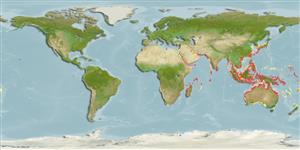Ελασμοβράγχιοι (καρχαρίες και σαλάχια) (sharks and rays) >
Myliobatiformes (Stingrays) >
Rhinopteridae (Cownose rays)
Etymology: Rhinoptera: Greek, rhinos = nose + Greek,pteron = fin, wing (Ref. 45335).
More on authors: Müller & Henle.
Environment: milieu / climate zone / depth range / distribution range
Οικολογία
Θαλασσινό(ά); Υφάλμυρο Υφαλόφιλο(α). Tropical; 30°N - 15°S, 55°E - 135°E (Ref. 114953)
Indo-West Pacific: Oman to the Philippines; north to Ryukyu Is.; south to eastern Indonesia.
Μέγεθος / Βάρος / Age
Maturity: Lm ? range ? - ? cm
Max length : 165 cm WD αρσενικό/απροσδιόριστο; (Ref. 114953); μεγ. δημοσιευμένο βάρος: 4.5 kg (Ref. 3965)
Short description
Κλείδες προσδιορισμού | Μορφολογία | Μορφομετρία
Double-lobed snout and indented forehead; jaws usually with 7 rows of plate-like teeth; no caudal fin (Ref. 5578). Brown above, white below (Ref. 5578).
Found in bays, estuaries, and near coral reefs (Ref. 12951), over sand and mud bottoms (Ref. 9710). Usually solitary or in small aggregations (Ref. 114953). However, large schools with up to 500 individuals have been reported (Ref. 12951). Feeds on clams, oysters and crustaceans (Ref. 12951). Lives to over 2 years in captivity (Ref. 12951). Ovoviviparous (Ref. 50449). Edible (Ref. 30573). Caught mainly by gill net fisheries (Ref. 114953), occasionally by bottom trawl, demersal inshore gillnet and tangle net fisheries. Utilized for its meat (Ref. 58048).
Life cycle and mating behavior
Γεννητική Ωρίμανση | Αναπαραγωγή | Γεννοβολία | Αβγά | Γονιμότητα | Προνύμφες
Males court by nipping the female's dorsum. Mating pair orient in a venter to venter position, and the male inserts one or both claspers. The pair usually rests on the substrate, with the female on top of the male. Mating lasts about 30 seconds (Ref. 12951) to 1 minute (Ref. 49562). Exhibit ovoviparity (aplacental viviparity), with embryos feeding initially on yolk, then receiving additional nourishment from the mother by indirect absorption of uterine fluid enriched with mucus, fat or protein through specialised structures (Ref. 50449). Size at birth ~60 cm WD. One large pregnant female (~130 cm WD) contained a single late-term embryo 61 cm WD (Ref.58048).
Last, P.R., W.T. White, M.R. de Carvalho, B. Séret, M.F.W. Stehmann and G.J.P. Naylor, 2016. Rays of the world. CSIRO Publishing, Comstock Publishing Associates. i-ix + 1-790. (Ref. 114953)
IUCN Red List Status (Ref. 130435: Version 2024-1)
Human uses
αλιεία: Εμπορικό(ά); αλιεία αναψυχής: ναί
Εργαλεία
Special reports
Download XML
Διαδικτυακές πηγές
Estimates based on models
Preferred temperature (Ref.
123201): 24.2 - 29.2, mean 28.4 °C (based on 3123 cells).
Phylogenetic diversity index (Ref.
82804): PD
50 = 0.5039 [Uniqueness, from 0.5 = low to 2.0 = high].
Bayesian length-weight: a=0.01122 (0.00641 - 0.01964), b=2.94 (2.78 - 3.10), in cm total length, based on LWR estimates for this species & (Sub)family-body (Ref.
93245).
Τροφικό Επίπεδο (Ref.
69278): 3.5 ±0.24 se; based on food items.
Ελαστικότητα (Ref.
120179): Πολύ χαμηλό, ελάχιστος χρόνος για διπλασιασμό πληθυσμού > 14 έτη (Fec=1-2).
Fishing Vulnerability (Ref.
59153): Very high vulnerability (85 of 100).
Nutrients (Ref.
124155): Calcium = 5.55 [0.68, 83.89] mg/100g; Iron = 0.366 [0.030, 4.005] mg/100g; Protein = 20.9 [15.6, 26.2] %; Omega3 = 0.0676 [, ] g/100g; Selenium = 30.8 [5.7, 156.0] μg/100g; VitaminA = 18.7 [1.7, 205.1] μg/100g; Zinc = 0.824 [0.056, 9.302] mg/100g (wet weight);
